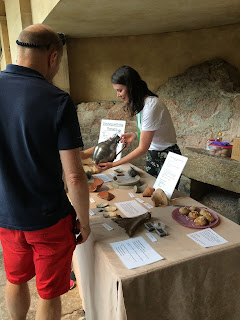‘A thing of beauty is a joy for ever’
John Keats
Health and beauty were considered important for Romans. They wanted to make themselves look as good as they could. From bathing in the public bathhouse to wearing glamorous jewellery, they put a lot of effort into maintaining their health and beauty. I chose some interesting objects that are in the Roman Baths collection on the subject of hygiene and jewellery and set up a handling table for visitors by the Great Bath.
 |
| Handling Roman objects by the Great Bath |
First of all, hygiene. The most popular object I had on the table was the pocket toilet set including ear-scoop, nail-cleaner and tweezers. Romans carried this toilet set on their belt or in a little bag to the bathhouse.
 |
| Left to Right: Tweezers, nail cleaner and ear scoop |
We can’t talk about Roman beauty without mentioning hairstyles. Roman women had elaborate hairstyles. They copied complicated hairstyles from coins or statues of the empress or important people. Many hairstyles required some hair pins made of bone or metal to keep the hair in place. Some even added hair pieces, and others wore wigs made from real hair. Slaves had to curl and pin the hair of their mistress. On the handling table, there was a bone hair pin and a beautifully preserved wooden comb on our handling table. Visitors loved the 2000 years old comb which was found in the Sacred Spring on our site.
 |
| Left to right: bone hair pin and wooden comb |
Last but not least is Roman jewellery. Finger-rings, bracelets, earrings, and necklaces were the most common items which completed their outfit. Brooches had a utilitarian function as clothes fasteners, however, we can assume that they also a decoration by looking at various designs of brooches. On our handling table, I had a copper alloy bow-brooch and its replica which helped to imagine what it might have looked like back in Roman times. Children enjoyed bow-brooch making activity using metallic card paper.
 |
| Left to right: Bow brooch and replica |
 |
| Bow brooch craft activity |
Although it was a replica, one of my favourite objects was a little ring-key. This key shaped ring was an actual key to lock caskets or strong boxes. Visitors were amazed by this clever solution for security.
 |
| Replica ring-key |
There are more objects on display at the Roman Baths which I strongly recommend you come to see. I wonder if you can spot the little display of an intricate penannular brooch (circle shaped brooch) near the King’s Bath on your visit.
Seohee
Placement Student
수요일의
한 줄: 로마시대의 아름다움
‘아름다움은 영원한 기쁨이다’-존 키츠의 시 엔디미온(Endymion) 중
건강과 아름다움을 유지하는 것은 로마인들에게 매우 중요했답니다.
그들은 할 수 있는 한 아름답게 자기자신을 가꾸려고 했어요. 대중 목욕탕에서 목욕을
하는 것부터 화려한 장신구를 착용하는 것까지 많은 노력을 기울였어요. 저는 로만 바스 박물관 컬렉션에서 로마시대의
아름다움과 관련된 유물들을 골라 수요일 저녁 Great Bath옆에 방문객들이 직접 만져볼 수 있는 핸들링
테이블을 마련했답니다. 물론 금속으로 된 것들이라 작은 상자 안에 각각 넣어두긴 했지만요.
 |
| 핸들링 테이블 |
먼저, 위생과 관련된 유물. 가장 인기가 많았던 유물은 귀이개, 손톱 클리너, 족집게였어요. 로마인들은 이것들을 고리에 연결하여 밸트에 달거나 작은 가방에 넣어 목욕탕에 가곤 했대요.
 |
| 왼쪽부터 족집게, 손톱 클리너, 귀이개 |
로마시대의 아름다움에 대해 이야기할 때 빼놓을 수 없는 것이 헤어스타일이예요. 로마시대 여성들은 굉장히 정교한 헤어스타일을 갖고 있었는데요, 동전이나 조각상에서 여제나 귀족 여성들의 헤어스타일이 유행을 선도했다고 해요. 복잡하게 땋고 틀어 올린 헤어스타일을 유지하기 위해서는 많은 헤어핀이 필요했는데, 헤어핀들은 주로 동물의 뼈나 금속으로 만들어졌어요. 아름다운 헤어스타일을 완성하기 위해서 어떤 사람들은 헤어 피스를 붙이기도 했고 가발을 착용하기도 했다고 해요. 부잣집 여주인들은 하녀들에게 자신의 머리카락을 곱슬곱슬하게 만들고 헤어핀을 이용해 스타일을 만들도록 했어요. 수요일의 핸들링 테이블에 우리는 뼈로 만들어진 헤어핀, 그리고 아름답게 보존된 나무 빗을 전시했어요. 방문객들은 여기 로만 바스의 Sacred Spring에서 발견된 2000년된 빗을 굉장히 좋아했답니다.
 |
| 외쪽부터 뼈 헤어핀, 나무 빗 |
마지막으로는 로마인들이 사랑했던 장신구입니다. 반지, 팔찌, 귀걸이 그리고 목걸이는 그 시대 사람들의 패션을 완성시켜주었던 가장 흔한 장신구예요. 브로치는 굉장히 느슨한 옷을 입었던 로마인들의 옷을 고정시켜주는 실용적인 기능을 갖고 있었지만, 화려하고 다양한 디자인의 브로치가 있었던 것을 보면 장식적인 역할도 했음을 짐작할 수 있어요. 우리의 핸들링 테이블에는 구리 합금으로 된 활모양의 브로치가 있었어요. 오랜 시간이 지난 금속 브로치라 변색이 되었지만, 우리가 갖고 있는 복제품은 당시에 얼마나 아름답고 반짝이는 브로치였는지 상상할 수 있게 해주었답니다. 어린이 방문객들은 우리가 준비한 활 모양 브로치 만들기 활동을 하며 즐거워했어요.
 |
| 활 모양 브로치와 복제품 |
 |
| 활 모양 브로치 만들기 활동 |
복제품이기는 하지만, 제가 가장 좋아했던 유물은 열쇠 반지였어요. 열쇠 모양으로 된 이 작은 반지는 실제로 로마인들이 작은 장식함이나 금고를 잠그는 열쇠로 쓰였다고 해요. 우리 테이블을 찾아준 많은 방문객들이 로마인들이 보안을 위해 만든 이 영리한 열쇠 반지를 보고 놀라워했답니다.
 |
| 열쇠 반지 (복제품) |
로만 바스 박물관에는 로마시대의 화려한 문화 유산을 느껴볼 수 있는 많은 유물들이 전시되어 있어요. 바스에 오실 일이 있다면 꼭 한 번 방문하길 추천합니다. 로만 바스에 오시면 King’s Bath 근처 작은 디스플레이 케이스에 아주 정교하고 아름다운 원형의 브로치가 있는데요, 한 번 찾아보시는 건 어떨까요?









